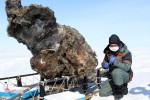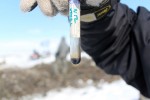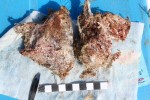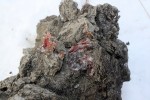 Scientists from the North-Eastern Federal University (NEFU) and the Russian Geographical Society have found the well-preserved of a female woolly mammoth on the Lyakhovsky Islands in the arctic seas of northeastern Russia. The mammoth died 10,000 – 15,000 years ago, and although her upper head, trunk, upper body and left hind leg were skeletonized from being exposed in the open tundra, the rest of her body was embedded in the permafrost which preserved the soft tissues. The team found fragments of what appear to be red muscle tissue and under the belly, a dark red liquid was trapped in ice cavities. When researchers broke the ice around the red liquid, it flowed out like it was fresh.
Scientists from the North-Eastern Federal University (NEFU) and the Russian Geographical Society have found the well-preserved of a female woolly mammoth on the Lyakhovsky Islands in the arctic seas of northeastern Russia. The mammoth died 10,000 – 15,000 years ago, and although her upper head, trunk, upper body and left hind leg were skeletonized from being exposed in the open tundra, the rest of her body was embedded in the permafrost which preserved the soft tissues. The team found fragments of what appear to be red muscle tissue and under the belly, a dark red liquid was trapped in ice cavities. When researchers broke the ice around the red liquid, it flowed out like it was fresh.
 The team is assuming this red liquid is blood from the deceased mammoth. The fact that it was running even in the subfreezing temperatures of the Siberian arctic (the temperature was -7 to -10 degrees Centigrade, 20 to 14 degrees Fahrenheit) suggested to the scientists that mammoth blood had a cryoprotectant to keep it from getting sluggish in the Ice Age climate, a feature arctic squirrels today have. Canadian researcher Kevin Campbell found in 2010 that compared to the Indian elephant, the mammoth’s closest living relative, mammoth hemoglobin released its oxygen to body tissues in extreme cold far more quickly and efficiently. Alternatively, the blood may have lost its water in the surrounding ice and become so highly concentrated that its freezing point was lowered. Perhaps some local bacteria living in the permafrost infected the sample and kept it liquid with their own cryoprotective properties.
The team is assuming this red liquid is blood from the deceased mammoth. The fact that it was running even in the subfreezing temperatures of the Siberian arctic (the temperature was -7 to -10 degrees Centigrade, 20 to 14 degrees Fahrenheit) suggested to the scientists that mammoth blood had a cryoprotectant to keep it from getting sluggish in the Ice Age climate, a feature arctic squirrels today have. Canadian researcher Kevin Campbell found in 2010 that compared to the Indian elephant, the mammoth’s closest living relative, mammoth hemoglobin released its oxygen to body tissues in extreme cold far more quickly and efficiently. Alternatively, the blood may have lost its water in the surrounding ice and become so highly concentrated that its freezing point was lowered. Perhaps some local bacteria living in the permafrost infected the sample and kept it liquid with their own cryoprotective properties.
 Scientists were able to take samples from a wide variety of tissues — blood vessels, glands, hair and blood — for laboratory analysis. Somebody had the foresight to bring a blood preservative with them, so they were able to ensure the liquid retrieved from the ice wouldn’t harden and dry up. The one-ton carcass was removed from the island to the mainland of the Republic of Sakha where it is being preserved in an icehouse. The exact location is being kept secret. They considered helicoptering the entire thing to the university in Yakutsk, but they decided the voyage was too long to keep the remains from defrosting and disaster.
Scientists were able to take samples from a wide variety of tissues — blood vessels, glands, hair and blood — for laboratory analysis. Somebody had the foresight to bring a blood preservative with them, so they were able to ensure the liquid retrieved from the ice wouldn’t harden and dry up. The one-ton carcass was removed from the island to the mainland of the Republic of Sakha where it is being preserved in an icehouse. The exact location is being kept secret. They considered helicoptering the entire thing to the university in Yakutsk, but they decided the voyage was too long to keep the remains from defrosting and disaster.
Since the NEFU team is partnering with controversial South Korean Sooam Biotech Research Foundation (its leader, former Seoul National University scientist Hwang Woo-suk, admitted to falsely claiming he had cloned human embryonic stem cells in 2004) on a long-term project to bring a mammoth back to life by cloning, the discovery of fresh-looking tissues and fluids makes them very happy. Much of the press about the find has been focused on the possibility of cloning woolly mammoth from 10,000 blood.  To call this prospect unlikely would be ridiculously optimistic. Even if that prosciutto-looking stuff really is preserved muscle tissue and that the dark red liquid is actually blood, the chances of any of these tissues having a single intact, viable cell that can be de-differentiated into a stem cell in order to produce a mammoth zygote that could then be implanted into an Indian elephant’s uterus, are vanishingly slim.
To call this prospect unlikely would be ridiculously optimistic. Even if that prosciutto-looking stuff really is preserved muscle tissue and that the dark red liquid is actually blood, the chances of any of these tissues having a single intact, viable cell that can be de-differentiated into a stem cell in order to produce a mammoth zygote that could then be implanted into an Indian elephant’s uterus, are vanishingly slim.
The Russian team plans to return with Sooam researchers and US scientists to the icehouse in late July, early August to do more research on the carcass. Hopefully they’ll do some solid paleontological research rather than just obsess about the remote cloning possibilities.
I can’t agree with your last comment, implying that the scientists have better paleontological work to do with the mammoth than look into the possibility of cloning. Mammoth carcasses are not extremely rare. Granted, something could be learned about the blood, if that is what it is, because of its apparent antifreeze qualities. But what makes the find so exciting is that, just possibly, a mammoth could be cloned from it. The most recent National Geographic goes into detail about the possibilities of bringing extinct animals back to life, and it was published before this discovery.
God creates mammoths. God destroys mammoths. God creates man. Man recreates mammoths. Mammoths destroy man.
It’s the circle of life.
🙂
Can I haz a ‘Sabretooth Mamoth’ ? …Maybe similar to this one ? – P.S.: It should at least have the aggressive character of a wild boar.
I want a mammoth cloned !
If they do clone a mammoth, I hope it talks like Ray Romano.
Why would anyone WANT to clone a wooly mammoth? Just to say they could? At this point, the wooly mammoth no longer plays a part in the Arctic ecosystem. I’d be more interested in the blood properties that allow it, and Arctic squirrels, to survive in extremely cold temperatures.
It’s not as if a cloned mammoth could tell us anything about what life was like during the Ice Age unless, of course, it does sound like Ray Romano.
mammoths destroy man?? You’re off your tiny rocker